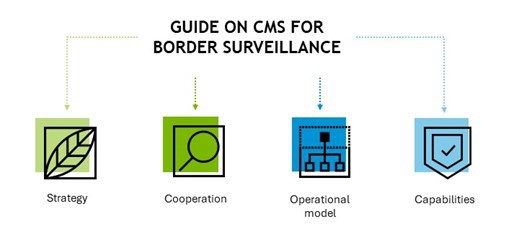Border surveillance is a complex process which plays an essential role in integrated border management. Every EU and Schengen country has its own national standards to define the minimum requirements for efficient surveillance activities. The development of common minimum standards for border surveillance was initiated in 2021 and Frontex took up the coordinator task.
The Guidelines for the Common Minimum Standards (CMS) for Border Surveillance were drafted to support the harmonisation of border surveillance concepts and practices within the European Border and Coast Guard community. They outline a set of practices and minimum denominators for what Member States consider adequate, effective, and timely for performing border surveillance in their national environments to safeguard EU’s external borders against various short-term and long-term risks.
According to the Schengen Borders Code, border surveillance refers to the surveillance of borders between border crossing points and the surveillance of border crossing points outside of fixed opening hours, to prevent persons from circumventing border checks. The main purposes of the surveillance of external borders are among others:
- to prevent and discourage unauthorised border crossings and keep record of such;
- to counter and discourage cross-border criminality e.g., through routine patrolling;
- to take measures against persons who have crossed the border illegally;
- to maintain reliable situational awareness and reaction capability;
- to support detection, identification and enforcement of all relevant procedures.
These Guidelines constitute a compendium of Member State border surveillance practices pertaining to three border environments: air, land, and sea. They cover strategic, operational, and tactical level factors impacting Member States’ situational awareness and reaction capabilities.
In more detail, the identified common minima address the main process phases that make up border surveillance in the Member States, such as:
- preparedness, i.e., the capabilities to anticipate and respond to changing operational situations at the external borders;
- reaction, i.e., actions aimed at responding to unauthorised cross-border activities at, along or in the proximity of the external borders;
- prevention, i.e., the activities and measures that apply to prevent unauthorised border crossings, crisis and events from occurring at external borders.
Providing guidance on CMS is part of Frontex’ mission to support the management of EU’s external borders by reinforcing, assessing, and coordinating the actions of the Member States. This activity reflects the text of Regulation (EU) 2019/1896 on the European Border and Coast Guard:
The Guidelines answer the need for such a compendium reported by the Member States. They represent an important step in harmonising national practices in border surveillance by complementing and aligning them with the existing initiatives addressing European integrated border management.
